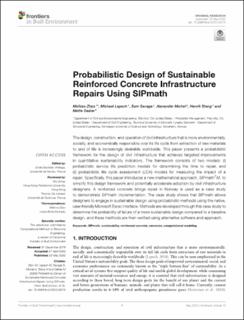| dc.contributor.author | Zirps, Melissa | |
| dc.contributor.author | Lepech, Michael | |
| dc.contributor.author | Savage, Sam | |
| dc.contributor.author | Michel, Alexander | |
| dc.contributor.author | Stang, Henrik | |
| dc.contributor.author | Geiker, Mette Rica | |
| dc.date.accessioned | 2020-06-08T11:54:06Z | |
| dc.date.available | 2020-06-08T11:54:06Z | |
| dc.date.created | 2020-05-23T07:45:37Z | |
| dc.date.issued | 2020 | |
| dc.identifier.citation | Frontiers in Built Environment. 2020, 6:72. | en_US |
| dc.identifier.issn | 2297-3362 | |
| dc.identifier.uri | https://hdl.handle.net/11250/2657212 | |
| dc.description.abstract | The design, construction, and operation of civil infrastructure that is more environmentally, socially, and economically responsible over its life cycle from extraction of raw materials to end of life is increasingly desirable worldwide. This paper presents a probabilistic framework for the design of civil infrastructure that achieves targeted improvements in quantitative sustainability indicators. The framework consists of two models: (i) probabilistic service life prediction models for determining the time to repair, and (ii) probabilistic life cycle assessment (LCA) models for measuring the impact of a repair. Specifically, this paper introduces a new mathematical approach, SIPmathTM, to simplify this design framework and potentially accelerate adoption by civil infrastructure designers. A reinforced concrete bridge repair in Norway is used as a case study to demonstrate SIPmath implementation. The case study shows that SIPmath allows designers to engage in sustainable design using probabilistic methods using the native, user-friendly Microsoft Excel interface. Methods are developed through this case study to determine the probability of failure of a more sustainable design compared to a baseline design, and these methods are then verified using alternative software and approach. | en_US |
| dc.language.iso | eng | en_US |
| dc.publisher | Frontiers Media | en_US |
| dc.rights | Navngivelse 4.0 Internasjonal | * |
| dc.rights.uri | http://creativecommons.org/licenses/by/4.0/deed.no | * |
| dc.title | Probabilistic Design of Sustainable Reinforced Concrete Infrastructure Repairs Using SIPmath | en_US |
| dc.type | Peer reviewed | en_US |
| dc.type | Journal article | en_US |
| dc.description.version | publishedVersion | en_US |
| dc.source.pagenumber | 13 | en_US |
| dc.source.volume | 6 | en_US |
| dc.source.journal | Frontiers in Built Environment | en_US |
| dc.identifier.doi | 10.3389/fbuil.2020.00072 | |
| dc.identifier.cristin | 1812219 | |
| dc.description.localcode | Copyright © 2020 Zirps, Lepech, Savage, Michel, Stang and Geiker. This is an open-access article distributed under the terms of the Creative Commons Attribution License (CC BY). The use, distribution or reproduction in other forums is permitted, provided the original author(s) and the copyright owner(s) are credited and that the original publication in this journal is cited, in accordance with accepted academic practice. No use, distribution or reproduction is permitted which does not comply with these terms. | en_US |
| cristin.ispublished | true | |
| cristin.fulltext | original | |
| cristin.qualitycode | 1 | |

